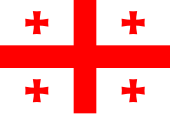
The Church of the Holy Sepulchre, also known as the Church of the Resurrection, is a fourth-century church in the Christian Quarter of the Old City of Jerusalem. It is considered to be the holiest site for Christians in the world and has been the most important pilgrimage site for Christians since the fourth century.

In heraldry, Saint George's Cross is a red cross on a white background, which from the Late Middle Ages became associated with Saint George, the military saint, often depicted as a crusader.

A saltire, also called Saint Andrew's Cross or the crux decussata, is a heraldic symbol in the form of a diagonal cross. The word comes from the Middle French sautoir, Medieval Latin saltatoria ("stirrup").
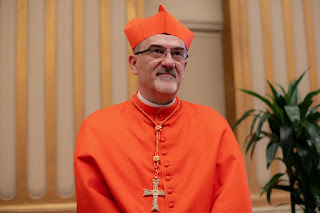
The Latin Patriarchate of Jerusalem is the Latin Catholic ecclesiastical patriarchate in Jerusalem, officially seated in the Church of the Holy Sepulchre. It was originally established in 1099, with the Kingdom of Jerusalem encompassing the territories in the Holy Land newly conquered by the First Crusade. From 1374 to 1847 it was a titular see, with the patriarchs of Jerusalem being based at the Basilica di San Lorenzo fuori le Mura in Rome. Pope Pius IX re-established a resident Latin patriarch in 1847.

The True Cross is said to be the real cross that Jesus of Nazareth was crucified on, according to Christian tradition.

The star and crescent is a symbol which is a conjoined representation of a crescent and a star. It is used in various historical contexts, including as a prominent symbol of the Ottoman Empire, and in contemporary times used as a national symbol for some countries, and a recognized symbol of Islam. It was developed in the Greek colony of Byzantium ca. 300 BC, though it became more widely used as the royal emblem of Pontic king Mithridates VI Eupator after he incorporated Byzantium into his kingdom for a short period. During the 5th century, it was present in coins minted by the Persian Sassanian Empire; the symbol was represented in the coins minted across the empire throughout the Middle East for more than 400 years from the 3rd century until the fall of the Sassanians after the Muslim conquest of Persia in the 7th century. The conquering Muslim rulers kept the symbol in their coinage during the early years of the caliphate, as the coins were exact replicas of the Sassanian coins.
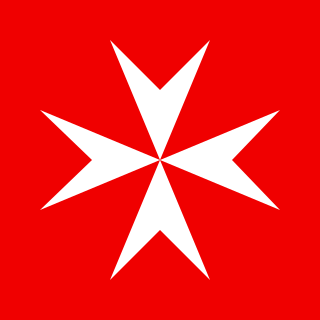
The Maltese cross is a cross symbol, consisting of four "V" or arrowhead shaped concave quadrilaterals converging at a central vertex at right angles, two tips pointing outward symmetrically.

The Greek Orthodox Patriarchate of Jerusalem, also known as the Greek Orthodox Church of Jerusalem, is an autocephalous church within the wider communion of Eastern Orthodox Christianity. Established in the mid-fifth century as one of the oldest patriarchates in Christendom, it is headquartered in the Church of the Holy Sepulchre in Jerusalem and led by the patriarch of Jerusalem, currently Theophilos III. The patriarchate's ecclesiastical jurisdiction includes roughly 200,000 to 500,000 Orthodox Christians across the Holy Land in Palestine, Jordan and Israel.

The Equestrian Order of the Holy Sepulchre of Jerusalem, also called Order of the Holy Sepulchre or Knights of the Holy Sepulchre, is a Catholic order of knighthood under the protection of the Holy See. The Pope is the sovereign of the order. The order creates canons as well as knights, with the primary mission to “support the Christian presence in the Holy Land.” It is an internationally recognised order of chivalry. The order today is estimated to have some 30,000 knights and dames in 60 lieutenancies around the world. The Cardinal Grand Master has been Fernando Filoni since 2019, and the Latin Patriarch of Jerusalem is ex officio the Order's Grand Prior. Its headquarters are situated at the Palazzo Della Rovere and its official church in Sant'Onofrio al Gianicolo, both in Rome, close to Vatican City.

The Via Dolorosa is a processional route in the Old City of Jerusalem. It represents the path that Jesus took, forced by the Roman soldiers, on the way to his crucifixion. The winding route from the former Antonia Fortress to the Church of the Holy Sepulchre—a distance of about 600 metres (2,000 ft)—is a celebrated place of Christian pilgrimage. The current route has been established since the 18th century, replacing various earlier versions. It is today marked by 14 Stations of the Cross, nine of which are outside, in the streets, with the remaining five stations being currently inside the Church of the Holy Sepulchre.
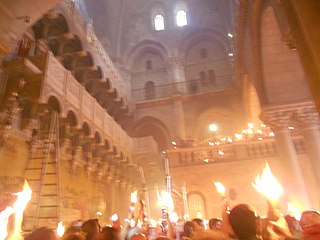
In Orthodox Christian belief, the Holy Fire is a ceremony that occurs every year at the Church of the Holy Sepulchre in Jerusalem on Great Saturday, the day before Orthodox Easter.
The Canons Regular of the Holy Sepulchre were a Catholic religious order of canons regular of the Rule of Saint Augustine, said to have been founded in the Church of the Holy Sepulchre in Jerusalem, then the capital of the Kingdom of Jerusalem, and recognised in 1113 by a Papal bull of Pope Paschal II. Other accounts have it that they were founded earlier, during the rule of Godfrey of Bouillon (1099–1100).

The grand master of the Teutonic Order is the supreme head of the Teutonic Order. It is equivalent to the grand master of other military orders and the superior general in non-military Roman Catholic religious orders. Hochmeister, literally "high master", is only used in reference to the Teutonic Order, as Großmeister is used in German to refer to the leaders of other orders of knighthood.

The Christian Quarter is one of the four quarters of the walled Old City of Jerusalem, the other three being the Jewish Quarter, the Muslim Quarter and the Armenian Quarter. The Christian Quarter is situated in the northwestern corner of the Old City, extending from the New Gate in the north, along the western wall of the Old City as far as the Jaffa Gate, along the Jaffa Gate - Western Wall route in the south, bordering on the Jewish and Armenian Quarters, as far as the Damascus Gate in the east, where it borders on the Muslim Quarter.

Jerusalem's role in first-century Christianity, during the ministry of Jesus and the Apostolic Age, as recorded in the New Testament, gives it great importance, both culturally and religiously, in Christianity. Jerusalem is generally considered the cradle of Christianity.

A cross potent, also known as a crutch cross, is a form of heraldic cross with crossbars at the four ends. In French, it is known as croix potencée, in German as a Krückenkreuz, all translating to "crutch cross".

A number of cross symbols were developed for the purpose of the emerging system of heraldry, which appeared in Western Europe in about 1200. This tradition is partly in the use of the Christian cross an emblem from the 11th century, and increasingly during the age of the Crusades. Many cross variants were developed in the classical tradition of heraldry during the late medieval and early modern periods. Heraldic crosses are inherited in modern iconographic traditions and are used in numerous national flags.

The Co-Cathedral of the Most Holy Name of Jesus, also known as the Holy Name of Jesus Co-Cathedral, is the co-cathedral, or technical cathedra of the Latin Patriarchate of Jerusalem. It is located in the Christian Quarter of the Old City of Jerusalem, about halfway between the New Gate and the Jaffa Gate, within the Old City walls.
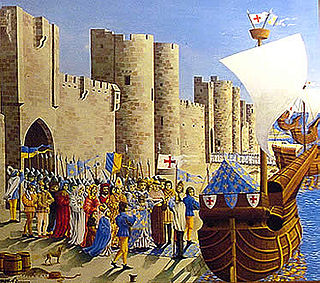
The history of Christian flags encompasses the establishment of Christian states, the Crusader era, and the 20th century ecumenical movement.

The Libellus de expugnatione Terrae Sanctae per Saladinum, also called the Chronicon terrae sanctae, is a short anonymous Latin account of the conquests of Saladin in the Holy Land between 1186 and 1191. The core of the text was written shortly after the events it describes and then supplemented by the addition of an account of the Third Crusade early in the thirteenth century. This probably took place at Coggeshall Abbey in England. Neither the original author nor the continuator/compiler is known by name.






